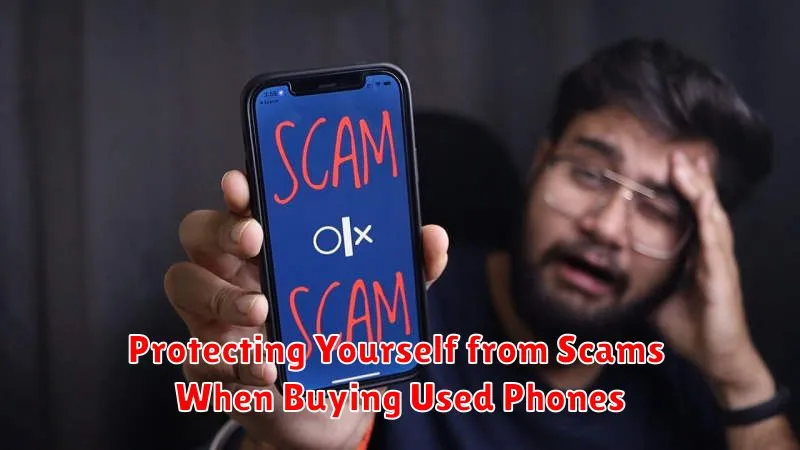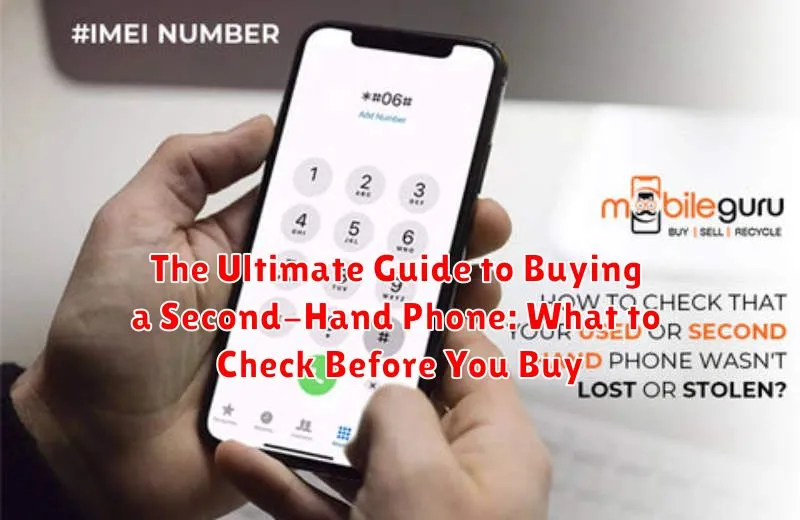Considering purchasing a second-hand phone? The used phone market offers incredible value, allowing you to acquire high-quality devices at significantly lower prices. This ultimate guide will equip you with the essential knowledge to navigate the pre-owned phone market successfully. Learn what crucial factors to check before you buy a used phone, ensuring you get a reliable device and avoid potential pitfalls. From inspecting the battery health and screen condition to verifying the IMEI and scrutinizing for hidden damage, this guide covers it all. Make an informed decision and secure a great deal on your next second-hand smartphone.
Buying a used phone can be a smart way to save money, but it’s essential to proceed with caution. This comprehensive guide outlines the key aspects to check before purchasing a pre-owned mobile device. We will walk you through the process of thoroughly evaluating a second-hand phone, covering everything from hardware assessments, including camera functionality and audio quality, to software verifications such as checking for operating system updates and identifying potential software glitches. By following these guidelines, you can confidently purchase a reliable and cost-effective second-hand phone that meets your needs.
Inspecting the Phone’s Physical Condition: Checking for Damage
A thorough physical inspection is crucial when buying a used phone. Start by examining the screen for any scratches, cracks, or dead pixels. Even minor scratches can worsen over time.
Next, check the phone’s body for dents, chips, or signs of bending. Pay close attention to the corners and edges, as these areas are prone to damage from drops. Inspect the charging port and headphone jack (if present) for any debris or damage that might affect their functionality.
Carefully examine the camera lens for scratches or cracks. These can significantly impact photo quality. Test all the buttons, ensuring they are responsive and function correctly.
If the phone has a removable back cover, remove it and inspect the battery compartment for any signs of corrosion or damage.
Assessing Battery Health in a Used Phone

A healthy battery is crucial for a good user experience. Check the battery health in the phone’s settings. iPhones provide a Battery Health percentage that gives a good indication of the battery’s condition. Android phones may have similar features, or you can use third-party apps to assess battery health.
Look for signs of battery wear. A bulging or swollen battery is a serious red flag and should be avoided. Also, inquire about the battery’s age. Older batteries naturally degrade over time and might need replacing sooner.
Observe the phone’s charging behavior. Does it charge quickly? Does it hold a charge well? Ask the seller about how long the phone typically lasts on a single charge to get a realistic idea of its current battery performance. A significantly short battery life could indicate a worn-out battery.
Testing the Phone’s Functionality: Making Calls and Checking Connectivity
A functional test is crucial when buying a used phone. Start by making a test call. Listen for clarity on both ends of the line. Check the speakerphone and microphone functionality as well.
Next, test the phone’s connectivity. Connect to available Wi-Fi networks and ensure the phone can browse the internet. If possible, test the cellular data connection too. Verify the strength and stability of the connection.
Bluetooth is another important feature to test. Pair the phone with another device, like headphones or a speaker, to confirm it works correctly.
Don’t forget to test the GPS functionality. Open a maps application and verify that the phone can accurately determine your location.
Verifying the Phone’s IMEI and Ownership Status
Before finalizing your purchase, verifying the phone’s IMEI (International Mobile Equipment Identity) is crucial. This unique number identifies the device and can help determine if it’s been reported lost or stolen.
To find the IMEI, dial *#06# on the phone’s keypad. Compare this number with the one printed on the phone’s box (if available) and in the phone’s settings. Discrepancies should raise a red flag.
Use an online IMEI checker to verify the phone’s status. These tools can reveal whether the phone has been blacklisted. Purchasing a blacklisted phone can result in connectivity issues.
In addition to verifying the IMEI, ensure the seller is the legitimate owner of the device. Ask for proof of purchase or any documentation that confirms their ownership. This helps protect you from unknowingly buying stolen property. A legitimate seller should be transparent and willing to provide this information.
Checking for Software Issues and Compatibility
Software can significantly impact user experience. Check the phone’s operating system (OS) version. Is it up-to-date? Outdated OS versions may have security vulnerabilities and lack support for newer apps. Look for any signs of unusual behavior like lagging, freezing, or unexpected restarts. These can indicate underlying software problems.
Compatibility is also key. If you plan on using specific apps or accessories, ensure they are compatible with the phone’s OS and hardware. Check the app store for availability and reviews related to compatibility issues. Consider any Bluetooth devices you use regularly and confirm their compatibility with the phone’s Bluetooth version.
If possible, factory reset the phone to observe its performance in a clean state. This helps reveal any hidden software issues that might be masked by the previous owner’s customizations. A factory reset also eliminates any personal data left behind, offering a fresh start.
Negotiating a Fair Price for the Used Phone
Once you’ve thoroughly inspected the used phone and are satisfied with its condition, it’s time to negotiate a fair price. Research similar models online to understand the current market value. Websites like eBay and Swappa can provide valuable insights into recent selling prices for phones with comparable specifications and condition.
Be prepared to walk away if the seller’s asking price is too high. Politely explain your reasoning based on your research and the phone’s condition. Highlight any flaws you’ve discovered during your inspection to justify a lower offer.
Start your offer lower than what you’re willing to pay, allowing room for negotiation. Be confident and reasonable in your counteroffers. A respectful negotiation benefits both parties and can lead to a mutually agreeable price.
Consider the included accessories when evaluating the price. A phone with original accessories like a charger and headphones can command a slightly higher price than one without. However, missing accessories can be a point of negotiation for a lower price.
Essential Accessories to Look For
While the phone itself is the primary focus, accompanying accessories can enhance the value of a used phone purchase. Check if the seller includes the original charging cable and adapter. A compatible charger ensures optimal charging speeds and prevents potential damage from using incorrect equipment.
Consider inquiring about headphones, although their inclusion is less common than the charging components. If the seller does offer headphones, examine their condition for any visible damage or wear.
Although less crucial, the original box and accompanying manuals can add value, especially for collectors or those who prioritize having the complete package. These items also aid in resale down the line.
Finally, inquire about any protective accessories like screen protectors or cases. These additions offer immediate protection for the device and can save you the cost of purchasing them separately.
Protecting Yourself from Scams When Buying Used Phones

Buying a used phone can be a great way to save money, but it’s crucial to be aware of potential scams. Protecting yourself starts with choosing reputable platforms. Favor established online marketplaces or certified pre-owned programs over less secure options like classified ads or social media groups.
Meet the seller in person whenever possible, in a safe public location. This allows you to inspect the phone thoroughly before exchanging money. Avoid deals that seem too good to be true, as these are often signs of counterfeit or stolen devices. Never wire money or use untraceable payment methods. Opt for secure payment options that offer buyer protection, such as escrow services or credit cards.
Thoroughly research the seller if purchasing online. Check their reviews, ratings, and feedback from other buyers. Be wary of sellers with limited history or overwhelmingly positive reviews, which could be fabricated. Ask the seller for the phone’s IMEI number and verify it with the carrier to ensure the device isn’t reported lost or stolen.
Finally, trust your instincts. If something feels off or makes you uncomfortable, walk away from the deal. It’s better to be safe than sorry when dealing with used electronics.

